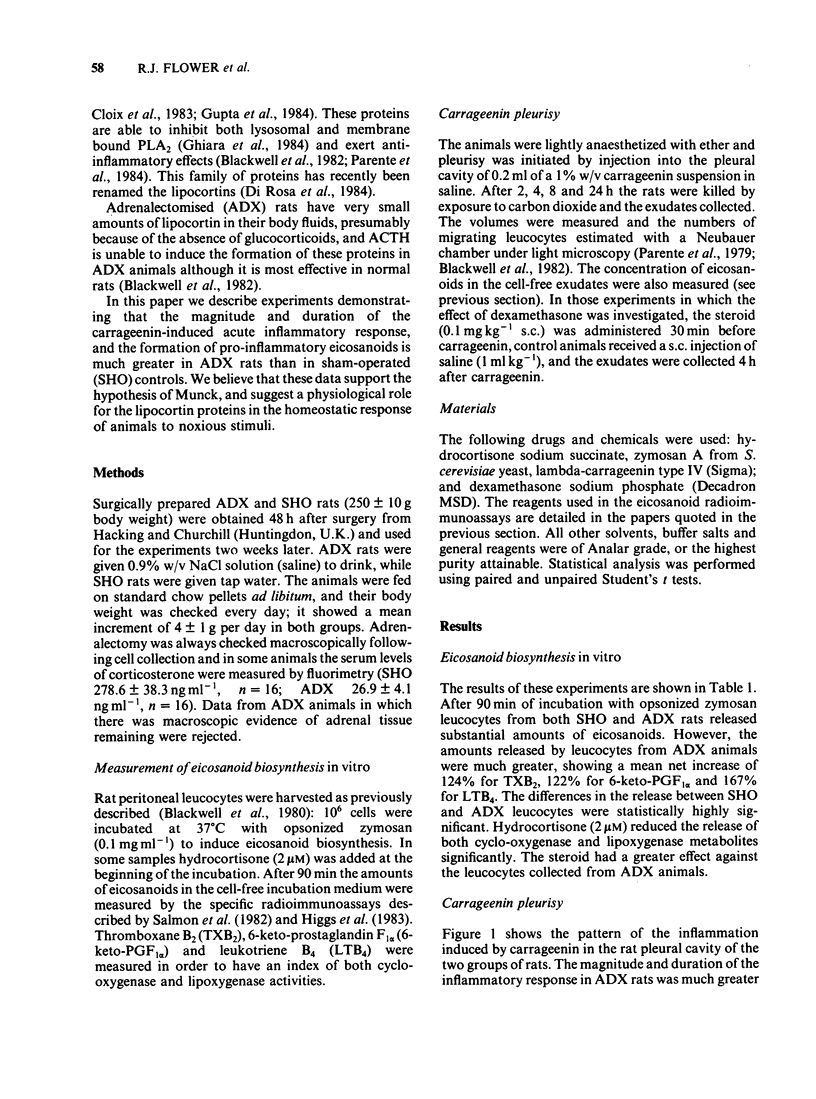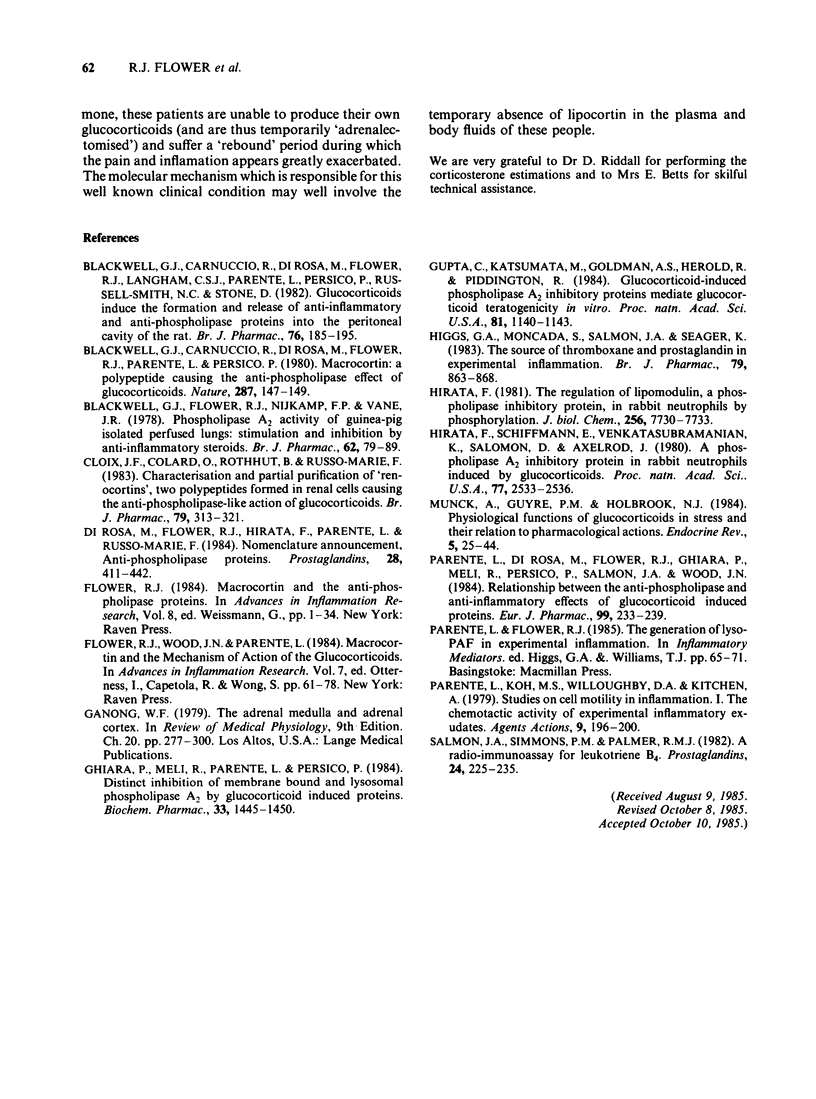Abstract
Carrageenin pleurisy was induced in adrenalectomised (ADX) and sham-operated (SHO) rats. The magnitude and duration of inflammation, as estimated by fluid exudation and cell migration, was greatly increased (approximately doubled) in ADX rats compared with that in their SHO controls. The content of eicosanoids (6-keto-prostaglandin F1 alpha (6-keto-PGF 1 alpha), thromboxane B2 (TXB2), and leukotriene B4 (LTB4] in inflammatory exudates from ADX rats was significantly (2-4 fold) greater than that of their SHO controls. Resident macrophages obtained from ADX rats produced more eicosanoids per cell per unit time when stimulated in vitro with zymosan, than did cells from the SHO controls. Administration of glucocorticoids blocked the inflammatory response and reduced the release of eicosanoids both in vitro and in vivo in both groups of rats. These data are consistent with the notion that physiological amounts of glucocorticoids exert a tonic inhibitory action on phospholipase activity in normal animals and that the increased secretion of these hormones during the inflammatory response serves to check and control the development of inflammation.
Full text
PDF





Selected References
These references are in PubMed. This may not be the complete list of references from this article.
- Blackwell G. J., Carnuccio R., Di Rosa M., Flower R. J., Langham C. S., Parente L., Persico P., Russel-Smith N. C., Stone D. Glucocorticoids induce the formation and release of anti-inflammatory and anti-phospholipase proteins into the peritoneal cavity of the rat. Br J Pharmacol. 1982 May;76(1):185–194. doi: 10.1111/j.1476-5381.1982.tb09205.x. [DOI] [PMC free article] [PubMed] [Google Scholar]
- Blackwell G. J., Carnuccio R., Di Rosa M., Flower R. J., Parente L., Persico P. Macrocortin: a polypeptide causing the anti-phospholipase effect of glucocorticoids. Nature. 1980 Sep 11;287(5778):147–149. doi: 10.1038/287147a0. [DOI] [PubMed] [Google Scholar]
- Blackwell G. J., Flower R. J., Nijkamp F. P., Vane J. R. Phospholipase A2 activity of guinea-pig isolated perfused lungs: stimulation, and inhibition by anti-inflammatory steroids. Br J Pharmacol. 1978 Jan;62(1):79–89. doi: 10.1111/j.1476-5381.1978.tb07009.x. [DOI] [PMC free article] [PubMed] [Google Scholar]
- Cloix J. F., Colard O., Rothhut B., Russo-Marie F. Characterization and partial purification of 'renocortins': two polypeptides formed in renal cells causing the anti-phospholipase-like action of glucocorticoids. Br J Pharmacol. 1983 May;79(1):313–321. doi: 10.1111/j.1476-5381.1983.tb10526.x. [DOI] [PMC free article] [PubMed] [Google Scholar]
- Di Rosa M., Flower R. J., Hirata F., Parente L., Russo-Marie F. Anti-phospholipase proteins. Prostaglandins. 1984 Oct;28(4):441–442. doi: 10.1016/0090-6980(84)90232-6. [DOI] [PubMed] [Google Scholar]
- Ghiara P., Meli R., Parente L., Persico P. Distinct inhibition of membrane-bound and lysosomal phospholipase A2 by glucocorticoid-induced proteins. Biochem Pharmacol. 1984 May 1;33(9):1445–1450. doi: 10.1016/0006-2952(84)90411-8. [DOI] [PubMed] [Google Scholar]
- Gupta C., Katsumata M., Goldman A. S., Herold R., Piddington R. Glucocorticoid-induced phospholipase A2-inhibitory proteins mediate glucocorticoid teratogenicity in vitro. Proc Natl Acad Sci U S A. 1984 Feb;81(4):1140–1143. doi: 10.1073/pnas.81.4.1140. [DOI] [PMC free article] [PubMed] [Google Scholar]
- Higgs G. A., Moncada S., Salmon J. A., Seager K. The source of thromboxane and prostaglandins in experimental inflammation. Br J Pharmacol. 1983 Aug;79(4):863–868. doi: 10.1111/j.1476-5381.1983.tb10530.x. [DOI] [PMC free article] [PubMed] [Google Scholar]
- Hirata F., Schiffmann E., Venkatasubramanian K., Salomon D., Axelrod J. A phospholipase A2 inhibitory protein in rabbit neutrophils induced by glucocorticoids. Proc Natl Acad Sci U S A. 1980 May;77(5):2533–2536. doi: 10.1073/pnas.77.5.2533. [DOI] [PMC free article] [PubMed] [Google Scholar]
- Hirata F. The regulation of lipomodulin, a phospholipase inhibitory protein, in rabbit neutrophils by phosphorylation. J Biol Chem. 1981 Aug 10;256(15):7730–7733. [PubMed] [Google Scholar]
- Munck A., Guyre P. M., Holbrook N. J. Physiological functions of glucocorticoids in stress and their relation to pharmacological actions. Endocr Rev. 1984 Winter;5(1):25–44. doi: 10.1210/edrv-5-1-25. [DOI] [PubMed] [Google Scholar]
- Parente L., Di Rosea M., Flower R. J., Ghiara P., Meli R., Persico P., Salmon J. A., Wood J. N. Relationship between the anti-phospholipase and anti-inflammatory effects of glucocorticoid-induced proteins. Eur J Pharmacol. 1984 Mar 23;99(2-3):233–239. doi: 10.1016/0014-2999(84)90246-2. [DOI] [PubMed] [Google Scholar]
- Parente L., Koh M. S., Willoughby D. A., Kitchen A. Studies on cell motility in inflammation. II. The in vivo effect of anti-inflammatory and anti-rheumatic drugs on chemotaxis in vitro. Agents Actions. 1979 Jun;9(2):196–200. doi: 10.1007/BF02024734. [DOI] [PubMed] [Google Scholar]
- Salmon J. A., Simmons P. M., Palmer R. M. A radioimmunoassay for leukotriene B4. Prostaglandins. 1982 Aug;24(2):225–235. doi: 10.1016/0090-6980(82)90148-4. [DOI] [PubMed] [Google Scholar]


